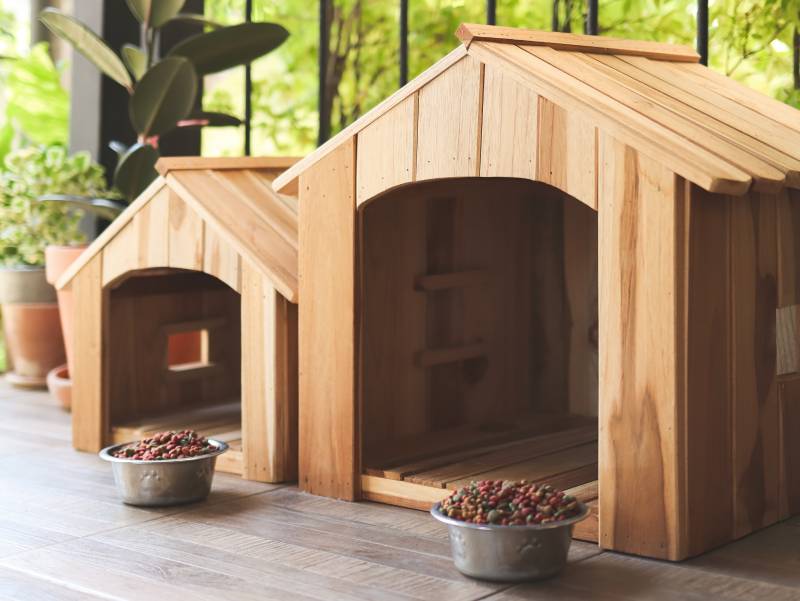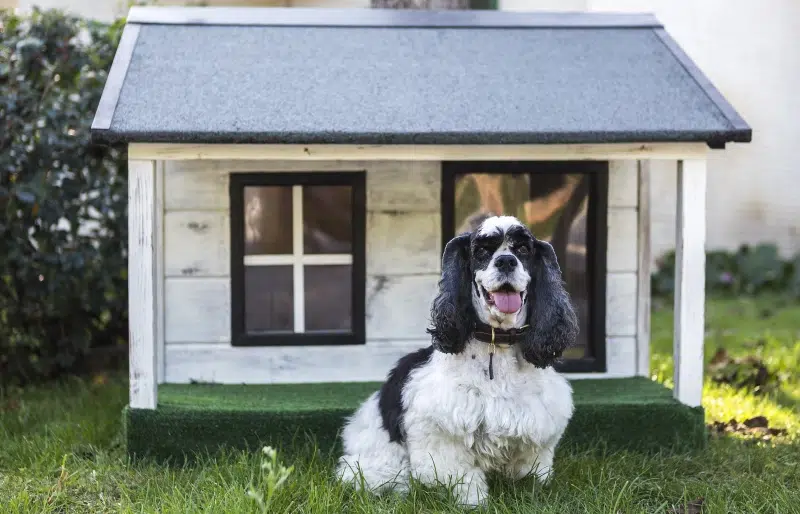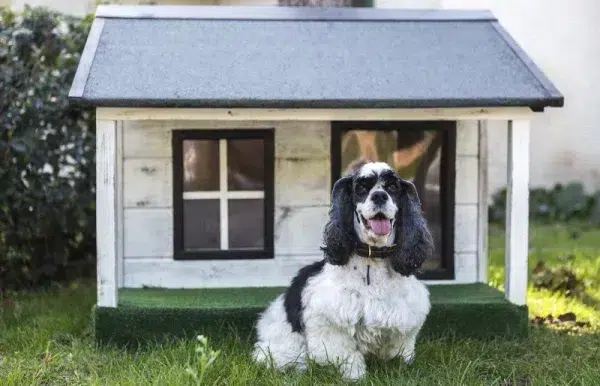Many dog owners mistakenly believe that dogs will naturally use a dog house. However, this is only true to some extent. Some dogs may decide to utilize a dog house to stay out of the weather, but many dogs may never use the dog house—even if it is pouring rain. These dogs need to be trained to use their dog house with any regularity.
In most areas, having your dog utilize their dog house is vital for them to stay cool, warm, and dry. Your dog will need to get out of the elements eventually, so it is best to start their training sooner rather than later.
Luckily, training your dog to use their dog house is a bit like training them to do anything else. It isn’t difficult, but it does require a time investment on your part.

The 4 Tips to Train Your Dog to Use Their Dog House
1. Leave Food in the Dog House
You want the dog house to be a fun place that your dog wants to use. Your canine may avoid going into the dog house because they don’t know what’s inside. Some dogs are a bit unsure of enclosed spaces like dog houses. However, putting some food inside can entice the dog to enter the house. Once the initial fear of the dog house subsides, many dogs will use their house to escape the rain.
This method is extremely simple. All you have to do is place a few treats inside the house and then walk away. Your dog should notice the treats eventually (if they don’t, you can encourage the discovery by pointing them out). Continue to do this every day or so until your dog is using the house without complaint.
Some dogs may be particularly scared of the dog house at first. These dogs may not even want to approach the dog house, and food may not be enough to entice them inside. Try leaving the treats near the dog house first and then slowly working them into the dog house.

2. Play Hide-and-Seek
If your dog is more on the playful side, you can play hide-and-seek with dog toys to encourage them to enter the house. Start by playing a game of fetch. Play it just like you normally would for a few rounds. Then, place the toy into the dog’s house. You can either place it gently into the house or throw the ball—whichever one seems to encourage your dog more.
Many dogs will chase the ball into the house without thinking. This method works just like the food one, but it involves a toy. The use of the toy around the dog house adds a positive association to the house, making it more likely that your dog will utilize it. Once your dog practices going in and out a few times, you can stop the training session. You may need to practice a few days in a row for your dog to be completely comfortable, though.
Again, some dogs may not go into the dog house even when a ball is placed inside. In this case, you’ll want to encourage the dog to be near the house first. Throw the toy near the house until your dog is comfortable going close to it. Next, you can put the toy on the doorway and slowly work it inside. Though this method takes a lot of patience, it’s one of the easiest ways to encourage your dog inside.
3. Make the Dog House Comfortable
It’s possible that some dogs don’t use their house because they don’t understand what it is. Try placing their usual bedding inside the house, as well as whatever other items make the house comfortable. (With that said, don’t leave the bedding in the house forever. Bedding doesn’t insulate when wet, and the inside of a dog house will absolutely get wet. Instead, you’ll need to use hay or a similar substance eventually).
Sometimes, the familiar scent of their bedding will help a dog feel more comfortable inside their dog house.

4. Change the Location
Other times, it isn’t the dog house itself that the dog doesn’t like but the location it’s in. If the dog house is in a far-off corner of the yard, your dog may never be near it enough to consider using it. Dogs prefer to bed down in areas they’re comfortable in. A corner of your yard may not fit into that category. Often, dogs prefer their dog houses to be closer to your house or in an area where they spend much of their time.
When placing a house, consider where your dog tends to be. In most cases, dogs spend the bulk of their time near the house. Therefore, placing the dog house up against the back of your house may make sense.
Don’t forget to consider wind direction, cover, and similar factors when placing the house, too. These factors matter just as much as your dog’s comfort. However, a poorly-placed house that your dog will use is almost always better than a house that’s never used.
Conclusion
It isn’t odd for dogs not to use their dog houses are quickly as their owners may expect. While dogs stereotypically love their dog houses, most take a while to warm up to them. You can help this process by placing their favorite toys or treats inside the house. Anything that encourages the dog to enter the house is a great option. However, don’t force your dog into the house, as this may make them more fearful than anything.
In most cases, training your dog to use a dog house takes a while. You have to be patient and may need to implement several of the methods we listed above. Luckily, most dogs do start using their dog house eventually.
Featured Image Credit: angel6000, Pixabay












